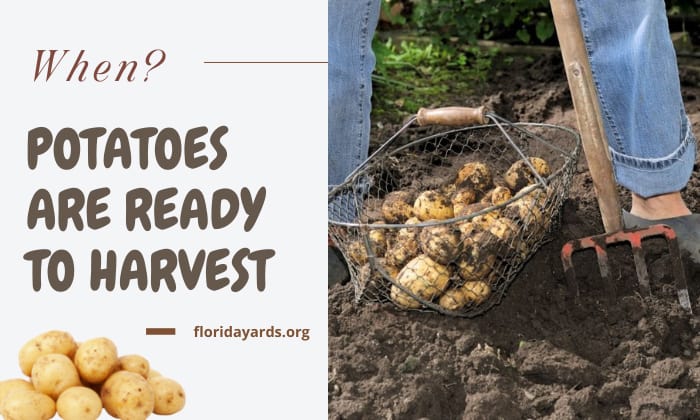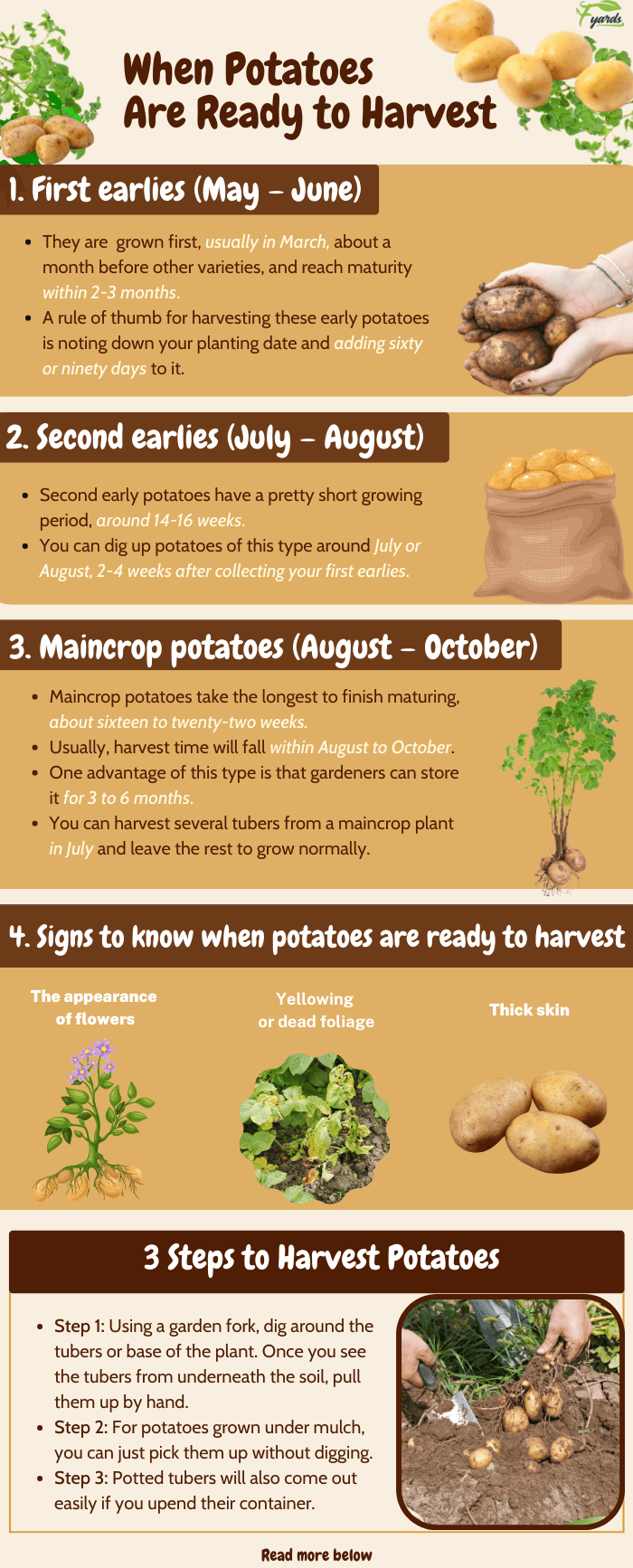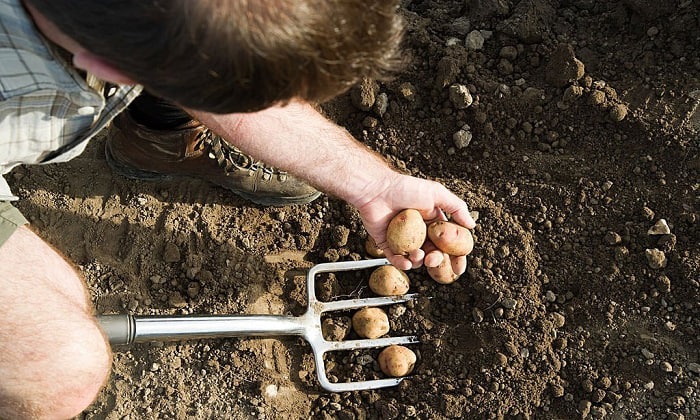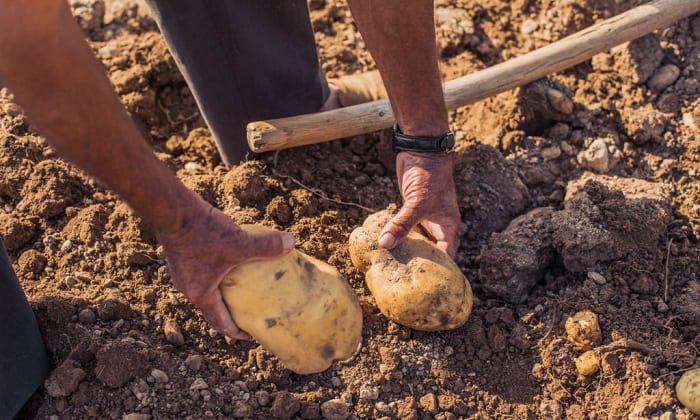Whether fried, baked, or boiled, potatoes are a staple in many kitchens. They can be either fluffy or firm, making them suitable for many dishes, from savory to sweet.
If you like to make French fries, latkes, or shepherd’s pies, perhaps you’re already growing white and red potatoes in your garden. In that case, it’s necessary to ask yourself: how to know when potatoes are ready to harvest?
The answer is not as straightforward as in games like Stardew Valley. That said, there are two main signs you can start harvesting potatoes: dying foliage and blooming flowers.
Table of Contents
How to Tell When Potatoes Are Ready to Harvest
The time to harvest potatoes depends on the maturation period of the potatoes you’re growing. There are three varieties you should know about: first earlies, second earlies, and maincrop.
1. First earlies (May – June)
True to their name, first earlies are the quickest to develop among the three potato types. They are also grown first, usually in March, about a month before other varieties, and reach maturity within two to three months.
So, a rule of thumb for harvesting these early potatoes is noting down your planting date and adding sixty or ninety days to it.
2. Second earlies (July – August)
Similar to the first earlies, second early potatoes have a pretty short growing period, around fourteen to sixteen weeks. You can dig up potatoes of this type around July or August, two to four weeks after collecting your first earlies.
3. Maincrop potatoes (August – October)
Compared to the previous varieties, maincrop potatoes take the longest to finish maturing, about sixteen to twenty-two weeks.
To determine what month and day to pull potatoes of this type, you can just add the plant’s maturation period to your sowing date. Usually, harvest time will fall within August to October.
Now, don’t let the lengthy development of maincrop potatoes deter you from planting them. One advantage of this type is that gardeners can store it for 3 to 6 months, a massive difference compared with the five days to four weeks range of early potatoes.
Plus, you can harvest several tubers from a maincrop plant in July and leave the rest to grow normally. These tubers you grab prematurely can be your early potatoes.
4. Signs to know when potatoes are ready to harvest
- The appearance of flowers
One tip you can try is to check your crop for flowers. Early potatoes often have them, as do maincrop ones, though to a lesser extent.
In any case, if you see fading blossoms, your tubers are ready. Now, you may be wondering if it is possible to harvest your plant before they have flowered.
If the cultivar you grow is known to have petals, then no, you should let nature take its course. Digging up potatoes too early means the tubers won’t be as large as they can be.
On the other hand, if you’re growing a variety with no flowers, there’s no point in relying on buds as an indicator for potatoes ready to harvest. A better way to check their development is to examine the foliage.
- Yellowing or dead foliage
For maincrop potatoes, you should check if the foliage and stems are dead. If they are, dig the plants up right away, as delaying this task might leave you with rotten crops.
Meanwhile, it’s best not to wait until all leaves are brown on early varieties. A mix of yellow and green foliage means it’s time to pick potatoes of this type.
Tip: Do brown leaves indicate blight or a potato plant ready to harvest? If you have difficulty differentiating the two, note that the latter will have brown spots, while the former will have brown spots with white rings.
- Thick skin
This tip applies to maincrop potatoes. When these are ready for harvest, their skin will be thick and not flake off easily if you rub them. On the other hand, early varieties should have thin skin, unless you leave them in the ground past the harvest date.
How to Harvest
Now that you know how to determine potato time to harvest, here are the basic steps to collect them.
- Step 1: Using a garden fork, dig around the tubers or base of the plant. Use your hands to move the soil around if you have trouble determining where the potatoes are. Once you see the tubers from underneath the soil, pull them up by hand.
- Step 2: For potatoes grown under mulch, you can just pick them up without digging.
- Step 3: Potted tubers will also come out easily if you upend their container.
Aside from the tips above, you should keep in mind the following:
- Harvest early potatoes when they’re mature and eat them right away. Otherwise, it’s possible to leave potatoes in the ground up to two weeks after they’re ready, then collect them.
- If you want to increase the size of early potatoes, pick up some tubers from a plant early and leave the rest untouched. If you do this, the tubers that remain in-ground will grow bigger.
- For all varieties of potatoes, do the harvesting when the ground is not wet and the weather is sunny.
How to Store Potatoes
Before storing potatoes, you should dry them under the sun. Alternatively, place them in a warm greenhouse to get all moisture out; this is one way to cure potatoes after harvest. Then:
- Keep early potatoes in containers with compost or sand if you want to store them for up to four weeks.
- Place both early and maincrop varieties in a dark and cool environment (40°F to 45°F).
- Check the potatoes before and during the storage period. Discard all damaged or diseased tubers; if not, they will ruin your healthy potatoes.
- Aside from containers, you can dig potatoes up and place them in Hessian and dull paper bags.
Frequently Asked Questions
Do I need to be hilling my potatoes?
I recommend that you hill up your potatoes. In other words, cover them with soil and leave only the foliage above the ground. The reasons are:
- Limiting potatoes’ exposure to sunlight ensures they’re subtly sweet and not bitter.
- Covering more of the potatoes with soil will protect them against frost.
- Hilling potatoes increases yield and helps control weeds.
Why are my potato plants too small/too tall?
Potatoes are usually 12 to 45 inches in height, so if your plant measures within this range, it’s not too tall or too small.
However, if your seedling is much bigger or tinier than the above limits, here are some possible causes for its unusual look:
- Too much nitrogen in the soil increases plant height.
- Lack of sunlight means the potato can’t synthesize energy for growth.
- The herbicide you used to control weeds has harmed the plant.
Can I eat potatoes right after harvest?
Yes. There’s no reason you can’t do so, especially if you grow early potatoes. These tubers don’t last long in storage, as mentioned above.
What’s more, if you eat potatoes immediately after collecting them, you also don’t need to prepare them for storage. Just go straight to prepping and cooking the tubers.
When is it time to harvest sweet potatoes?
It may surprise you to learn that sweet potatoes and potatoes are from different families. However, these plants share one similarity: being harvestable when their leaves turn yellow and die.
Where do potatoes grow?
Potatoes will thrive in hardiness zone 3 to 10b. That’s why nearly every part of the US can accommodate them. You’ll find these tubers in Kansas, Idaho, Washington, Wisconsin, and more.
Conclusion
Hopefully, the tips above answered your question of “how to know when potatoes are ready to harvest?”
As long as you pay attention to the physical changes of your plant and mark your seeding dates on a calendar, collecting potatoes when they’re ready will be easy-peasy.
Do you have a potato garden in your home? If not, perhaps it’s time to start one.
There are other gardening tips you can refer to:
- Ways to till a garden without a tiller.
- Steps to get rid of gnats with dawn dish soap.
- Tips to soften leather gardening gloves.

Hi, I am William – Floridayards’ digital content creator. My job is to find answers to all your concerns with thorough research and our team’s expert advice. I will also bring you honest reviews on the best products and equipment for raising your beautiful garden. Please look forward to our work!















